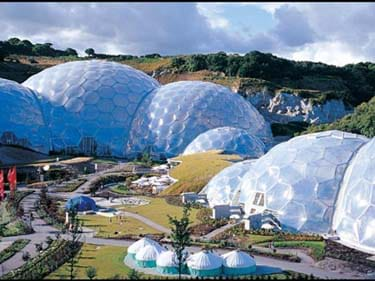
Summary
As students learn about the creation of biodomes, they are introduced to the steps of the engineering design process, including guidelines for brainstorming. They learn how engineers are involved in the design and construction of biodomes and use brainstorming to come up with ideas for possible biodome designs. This lesson is part of a series of six lessons in which students use their growing understanding of various environments and the engineering design process, to design and create their own model biodome ecosystems using the series of associated activities.Engineering Connection
Engineers and scientists design biodomes to study ecosystems by modeling how living and nonliving things interact in their natural environments. To develop a human-made environment, such as a biodome, engineers follow the steps of the engineering design process to generate ideas and create prototypes or models. Engineers design, create and test projects in advance so as to increase the chance of success for the final product. The practice of brainstorming and designing through the engineering design process is used throughout all of the engineering disciplines.
Learning Objectives
After this lesson, students should be able to:
- Define a biodome as a human-built environment used to study interactions of organisms.
- Describe brainstorming as a step in the engineering design process.
- Explain the steps of the engineering design process.
- Explain how engineers are involved with the design and construction of biodomes.
- Construct an argument with evidence that certain habitats are more suitable for certain organisms.
Educational Standards
Each TeachEngineering lesson or activity is correlated to one or more K-12 science,
technology, engineering or math (STEM) educational standards.
All 100,000+ K-12 STEM standards covered in TeachEngineering are collected, maintained and packaged by the Achievement Standards Network (ASN),
a project of D2L (www.achievementstandards.org).
In the ASN, standards are hierarchically structured: first by source; e.g., by state; within source by type; e.g., science or mathematics;
within type by subtype, then by grade, etc.
Each TeachEngineering lesson or activity is correlated to one or more K-12 science, technology, engineering or math (STEM) educational standards.
All 100,000+ K-12 STEM standards covered in TeachEngineering are collected, maintained and packaged by the Achievement Standards Network (ASN), a project of D2L (www.achievementstandards.org).
In the ASN, standards are hierarchically structured: first by source; e.g., by state; within source by type; e.g., science or mathematics; within type by subtype, then by grade, etc.
NGSS: Next Generation Science Standards - Science
| NGSS Performance Expectation | ||
|---|---|---|
|
3-LS4-3. Construct an argument with evidence that in a particular habitat some organisms can survive well, some survive less well, and some cannot survive at all. (Grade 3) Do you agree with this alignment? |
||
| Click to view other curriculum aligned to this Performance Expectation | ||
| This lesson focuses on the following Three Dimensional Learning aspects of NGSS: | ||
| Science & Engineering Practices | Disciplinary Core Ideas | Crosscutting Concepts |
| Construct an argument with evidence. Alignment agreement: | For any particular environment, some kinds of organisms survive well, some survive less well, and some cannot survive at all. Alignment agreement: | Knowledge of relevant scientific concepts and research findings is important in engineering. Alignment agreement: |
| NGSS Performance Expectation | ||
|---|---|---|
|
5-ESS2-1. Develop a model using an example to describe ways the geosphere, biosphere, hydrosphere, and/or atmosphere interact. (Grade 5) Do you agree with this alignment? |
||
| Click to view other curriculum aligned to this Performance Expectation | ||
| This lesson focuses on the following Three Dimensional Learning aspects of NGSS: | ||
| Science & Engineering Practices | Disciplinary Core Ideas | Crosscutting Concepts |
| Develop a model using an example to describe a scientific principle. Alignment agreement: | Earth's major systems are the geosphere (solid and molten rock, soil, and sediments), the hydrosphere (water and ice), the atmosphere (air), and the biosphere (living things, including humans). These systems interact in multiple ways to affect Earth's surface materials and processes. The ocean supports a variety of ecosystems and organisms, shapes landforms, and influences climate. Winds and clouds in the atmosphere interact with the landforms to determine patterns of weather. Alignment agreement: | A system can be described in terms of its components and their interactions. Alignment agreement: |
International Technology and Engineering Educators Association - Technology
-
Apply the technology and engineering design process.
(Grades
3 -
5)
More Details
Do you agree with this alignment?
-
Illustrate that there are multiple approaches to design.
(Grades
3 -
5)
More Details
Do you agree with this alignment?
State Standards
Colorado - Science
-
Identify the components that make a habitat type unique
(Grade
4)
More Details
Do you agree with this alignment?
-
Compare and contrast different habitat types
(Grade
4)
More Details
Do you agree with this alignment?
Worksheets and Attachments
Visit [www.teachengineering.org/lessons/view/cub_bio_lesson02] to print or download.Pre-Req Knowledge
Some knowledge about environments and ecosystems, as introduced in Lesson 1 of the Biodomes unit.
Introduction/Motivation
Who knows what a biodome is? (Working in small groups or pairs, ask students to come up with a definition of a biodome.) A biodome is a model that is built to represent a particular environment and the community of organisms that live there. Biodomes are a way to model ecosystems so we can study how living and nonliving things interact in their natural environments. Do you know what professionals would be involved with the design and construction of a biodome? Who helps decide what it looks like and what is inside of it? Engineers and scientists work together to develop a plan for the biodome, and then engineers work to design and construct the model environment using the plan. Biodomes often look really neat and different. (Optional: Consider showing students the attached PowerPoint presentation, Biodomes Visual Aids, Figure 1, photographs in the Lesson Background & Concepts for Teachers section, or images from internet resources listed in the References section.) Engineers come up with all sorts of designs using the engineering design process and eventually they settle on the best one.

What is the engineering design process? It is steps that engineers take when designing a new or improved product. It includes 1) finding a problem or need, 2) researching the problem, 3) coming up with creative ideas, 4) selecting the most promising idea, 5) creating or building a prototype of the design, and 6) testing and evaluating what you have built and 7) improving and redesigning as needed. One of the early important steps is coming up with ideas or brainstorming. Have any of you done this before? What is brainstorming? Brainstorming is a way to come up with as many ideas as possible, no matter how silly they are! This process can help you to find new creative solutions to old problems. Today, we are going to practice brainstorming, just like engineers. There are important guidelines to help us brainstorm. They are: (Write the Brainstorming Guidelines on the board, or display somewhere in the classroom, or distribute the Engineering Design Process Handout)
- No negative comments allowed.
- Encourage wild ideas.
- All ideas are recorded.
- Stay focused on topic.
- One conversation at a time.
- Build on the ideas of others.
Now, let's try brainstorming. (Divide the class into engineering teams of three or four students each.) First of all, I want each engineering team to agree on the environment for which you would like to make a biodome. Then, as a group, brainstorm what this biodome would look like in real life. Remember all biodomes are different. Every person in the team should contribute their ideas, and build on the ideas of each other. Make a list of all the ideas you generate about what your biodome would look like and what you could put in it. Remember, no idea is silly! You have five minutes to come up with a list of ideas. Then, we will share your ideas with the class. This way, we are starting to work and think just like engineers, who use this technique to get together to brainstorm and share ideas.
Lesson Background and Concepts for Teachers
A biodome is a controlled, human-made environment or biome. A biome is a major regional group of distinctive plant and animal communities best adapted to a region's natural environment, latitude, altitude and terrain. Think about your current biome. What are some organisms that thrive well here? (Answers may vary, i.e. deer, squirrels, maple trees, aspen trees). What are some organisms that cannot live here? (Answers may vary, i.e. polar bears, flamingos, whales). Biodomes can focus on one biome, or can attempt to bring many biomes together. Biomes are classified into categories, and a basic division would be terrestrial biomes and aquatic biomes. The major biomes of North America include: arctic and alpine tundra, coniferous forest, grasslands, deciduous forest, desert, and tropical rain forest. Figure 2 shows the major biomes in the world (this map may be downloaded for classroom use; see the Additional Multimedia Support section).
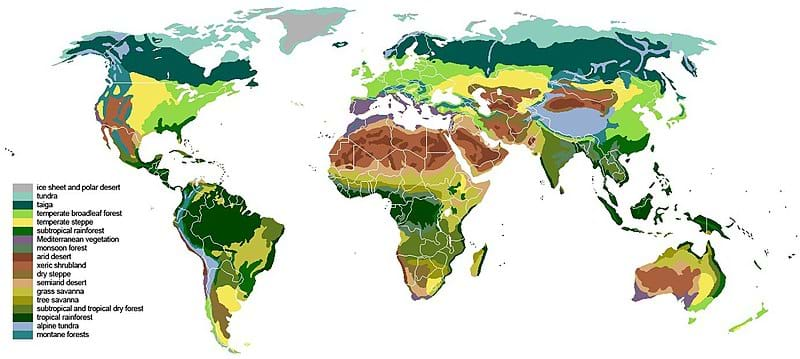
Over the years, creating a successful biodome that achieves balanced plant and animal life has proven to be a major challenge for the scientific and engineering communities. In particular, it is a challenge for engineers to eliminate human influence from the model environment, because this human influence can alter the study of environmental interactions within the artificial habitat of the biodome.
Biosphere 2, Arizona, USA
One of the largest biodome projects — an attempt to create a self-contained ecological system — is Columbia University's Biosphere 2. The name came from the idea that Earth is Biosphere 1. Starting in 1987, a private individual built a large set of biodomes in the Arizona desert (see Figure 3) to house several people for over a year in a (nearly) closed ecosystem.
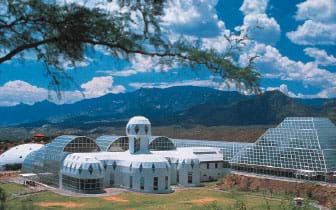
Biosphere 2 goals were to see if people could live and work in an enclosed biosphere, while concurrently collecting data from scientific experiments. The project was also designed to enable manipulation of a biosphere without causing damage to Earth's environment. The project eventually failed because oxygen levels in the biodome fell to dangerously low levels, and oxygen had to be pumped in to maintain life. While creation of this large and completely enclosed environment was a huge success for science and engineering, the project also demonstrated shortfalls when it failed to achieve the balance necessary to sustain life.
The Eden Project, England
One of the largest current biodome projects is The Eden Project near Cornwall, England (see Figures 1 and 4). Their mission statement, "To promote the understanding and responsible management of the vital relationship between plants, people and resources leading to a sustainable future for all," communicates their goal to educate the public on how to successfully maintain plant resources for the future. (Optional: Show students real biodome photographs from The Eden Project in the UK; see Internet sources in the References section.)
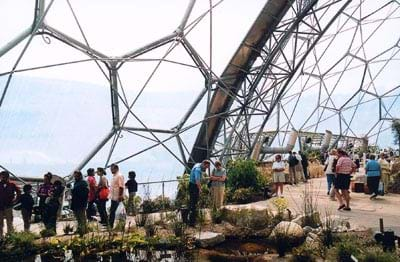
Begun in 2000 as an educational project, The Eden Project focuses on plant life. On the project grounds are more than 100,000 plants representing 5,000 species from various world climatic regions. While many of these plants can grow in the moderate Cornwall climate, others require two greenhouses to maintain suitable growing conditions. The Eden Project is home to the world's largest greenhouse — a humid tropics biome — that houses native rain forest plants such as banana, rubber, coffee and cocoa. The other engineered biome is the temperate biome, which contains plants from the Mediterranean, South Africa and California. The design and creation of these large geodesic structures is a great engineering accomplishment.
The Montreal Biodome
The Montreal Biodome, located in the 1976 Olympics velodrome, houses replicas of four eco-systems found in the Americas: forest, rain forest, polar and estuary. A variety of animals, birds and fish live in the simulated habitats. Students can create their own model biodome in the hands-on activity Biodomes Engineering Design Project: Lessons 2-6.
Associated Activities
- Biodomes Engineering Design Project: Lessons 2-6 - Following the steps of the engineering design process, students brainstorm, design, and create model biodomes of a particular environment (Parts 1 and 2, see Figure 5). Through subsequent lessons in the Biodomes unit, students continue to develop their model biodomes, following the instructions provided in the Procedure section in this activity.
Lesson Closure
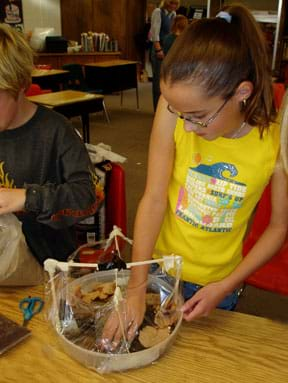
Today we have learned many things about biodomes. Who can define a biodome? (Possible answer: A biodome is a model that is built to represent a particular environment and the community of organisms that live there. Biodomes model how living and nonliving things interact in their natural environments. Biodomes are used to study ecosystems.) Who helps design and create these biodomes? Engineers, of course!
We also learned a little about the engineering design process. What is it? (Answer: It is a set of seven steps that engineers take when designing a new or improved product.) Which step(s) of the design process did we use today? (Answer: Brainstorming and design.) What are some brainstorming guidelines? (Answer: No negative comments allowed, encourage wild ideas, all ideas are recorded, stay focused on topic, one conversation at a time, and build on the ideas of others.) Now, we are ready to learn more about the parts of the environment to include inside our own model biodomes. Let's think like engineers and follow the steps of the engineering design process to create a model of a biodome of a specific environment.
Vocabulary/Definitions
biodome: A human-made, closed environment containing plants and animals existing in equilibrium.
biome: An area with a certain set of ecological characteristics, including a specific climate, plants and animals living in it.
biosphere: The part of the Earth's atmosphere that is capable of supporting life and includes both living and nonliving things.
brainstorming: A technique of solving specific problems, stimulating creative thinking and developing new ideas by unrestrained and spontaneous discussion.
ecosystem: A functional unit consisting of all the living organisms (plants, animals and microbes) in a given area, and all the nonliving physical and chemical factors of their environment, linked together through nutrient cycling and energy flow. An ecosystem can be of any size — a log, pond, field, forest or the Earth's biosphere — but it always functions as a whole unit.
engineer: A person who applies scientific and mathematical principles to creative and practical ends such as the design, manufacture and operation of efficient and economical structures, machines, processes and systems.
engineering design process: The design, build and test loop used by engineers. The steps of the design process include: 1) Define the problem, 2) Come up with ideas (brainstorming), 3) Select the most promising design, 4) Communicate the design, 5) Create and test the design, and 6) Evaluate and revise the design.
habitat: The natural home of a plant or animal.
model: (verb) To simulate, make or construct something to help visualize or learn about something else (as the living human body, a process or an ecosystem) that cannot be directly observed or experimented upon. (noun) A representation of something, sometimes on a smaller scale.
Assessment
Pre-Lesson Assessment
Group Definitions: Ask students to work in pairs or small teams to define the word biodome. And, include who is involved in the design and construction of biodomes.
Post-Introduction Assessment
Idea Web: Ask students to brainstorm a list of environments and the organisms you could find in those environments. What interactions do these organisms have with each other in these environments? Which organisms depend on each other for survival? (Example environments: Desert, forest, grassland, tundra, aquatic, tropical rain forest, polar, temperate, estuary, etc. See Lesson 1 for examples of environments and the plants, animals and soils found in them.)
Brainstorming Biodomes 1: Working in pairs or small groups, have students engage in open discussion on the following question. Remind them that in brainstorming, no idea or suggestion is "silly." All ideas should be respectfully heard. Encourage wild ideas and discourage criticism of ideas.
- What might a biodome look like for a particular environment? (Either give students a specific environment or let them choose their own.)
Lesson Summary Assessment
Brainstorming Biodomes 2: Once the pairs or small groups of students have brainstormed some ideas, have the teams volunteer to present their ideas to the class. Engage the class in a discussion about the differences between each biodome idea that was presented and how engineers use brainstorming to generate as many ideas as possible.
Concept Reflections / Journal Writing: Have students each write a short paragraph on the engineering design process, the benefits of brainstorming as a step in the design process, and what types of engineers would be involved with the design and construction of these biodomes.
Homework
Brainstorming at Home: Assign students to employ what they have learned about brainstorming and the engineering design process at home. Instruct them to take home the Engineering Design Process Handout and lead their family members in a brainstorming session to come up with great ideas that help the family. For example, to come up with ideas for: what to do on a Saturday afternoon, better ways to assign household chores, better ways to efficiently share bathrooms in the mornings, improved ways to organize the garage, basement, toys or kitchen cabinets, where to go on a family vacation, or any other problem-solving situation. Suggest that they remind their family members of the guidelines for successful brainstorming. Can they follow through on the engineering design process steps to reach a good solution? Have students describe the process and its results in two paragraphs.
Lesson Extension Activities
- Assign students to pick one of these biomes (arctic tundra, desert, or tropical rainforest) and research it at home. They should answer the following questions and find evidence that supports their answers:
- Give two examples of organisms that thrive well in this environment.
- ive two examples of organisms that thrive less well in this environment, but can still live there.
- Give two examples of organisms that cannot thrive at all in this environment.
- Assign students to research biodomes at home, on the internet or in the library. While there have been many attempts, most have not been successful. Ask students to hypothesize on why or why not a biodome was successful and make suggestions for improvements. Explain that engineers build on each others' ideas by making improvements to existing projects or products.
Additional Multimedia Support
Major Biomes Map. Last updated September 8, 2003. Soils, Natural Resources Conservation Service (NRCS), U.S. Department of Agriculture. Accessed October 10, 2006. (High quality image of world map showing major biomes in various colors, suitable for learning about the global distribution of major soil and climate types) < http://soils.usda.gov/use/worldsoils/mapindex/biomes.html >.
Subscribe
Get the inside scoop on all things TeachEngineering such as new site features, curriculum updates, video releases, and more by signing up for our newsletter!More Curriculum Like This

In this multi-day activity, students explore environments, ecosystems, energy flow and organism interactions by creating a scale model biodome, following the steps of the engineering design process.

Students explore the biosphere and its associated environments and ecosystems in the context of creating a model ecosystem, learning along the way about the animals and resources. This lesson is part of a series of six lessons in which students use their growing understanding of various environments...

Students learn about energy and nutrient flow in various biosphere climates and environments. They learn about herbivores, carnivores, omnivores, food chains and food webs, seeing the interdependence between producers, consumers and decomposers. This lesson is part of a series of six lessons in whic...
References
Biome. Last modified October 8, 2006. Wikipedia, the free encyclopedia. Accessed October 10, 2006. http://en.wikipedia.org/wiki/Biome
Biosphere 2. Biosphere 2, Tuscon, AZ. Accessed October 26, 2006. http://www.bio2.com/
Dictionary.com. Lexico Publishing Group, LLC. Accessed October 10, 2006. (Source of some vocabulary definitions, with some adaptation) http://www.dictionary.com
The Eden Project. Posted October 4, 2006. Awards, Millennium Commission, UK. Accessed October 10, 2006. http://www.millennium.gov.uk/cgi-site/awards.cgi?action=detail&id=172
The Eden Project. Eden Project Ltd., UK. Accessed October 10, 2006. http://www.edenproject.com/
Neighborhoods: Ecosystems, Biomes and Habitats. Living Things: Habitats & Ecosystems, The Franklin Institute Online. Accessed October 102, 2006. http://www.fi.edu/tfi/units/life/habitat/habitat.html
WorldBiomes.com. Last modified April 14, 2003. WorldBiomes.com. Accessed October 10, 2006. http://www.worldbiomes.com/
The World's Biomes. Museum of Paleontology, University of California, Berkeley. Accessed October 10, 2006. (Good description of five biomes: aquatic, deserts, forests, grasslands and deserts) http://www.ucmp.berkeley.edu/glossary/gloss5/biome/
Other Related Information
(optional: Show students the What Is Engineering? video)
Copyright
© 2006 by Regents of the University of Colorado.Contributors
Katherine Beggs; Malinda Schaefer Zarske; Denise W. CarlsonSupporting Program
Integrated Teaching and Learning Program, College of Engineering, University of Colorado BoulderAcknowledgements
The contents of this digital library curriculum were developed under a grant from the Fund for the Improvement of Postsecondary Education (FIPSE), U.S. Department of Education and National Science Foundation GK-12 grant no. 0338326. However, these contents do not necessarily represent the policies of the Department of Education or National Science Foundation, and you should not assume endorsement by the federal government.
Last modified: February 5, 2024










User Comments & Tips